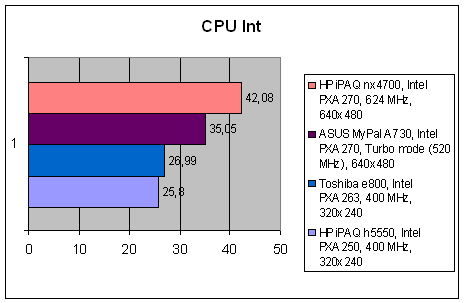
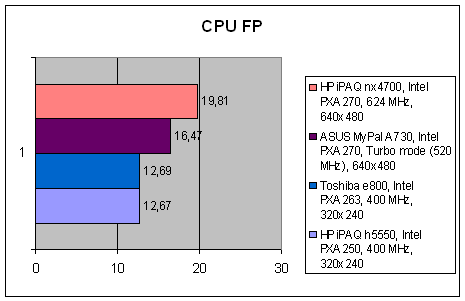
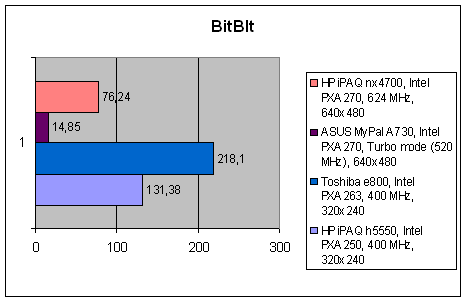
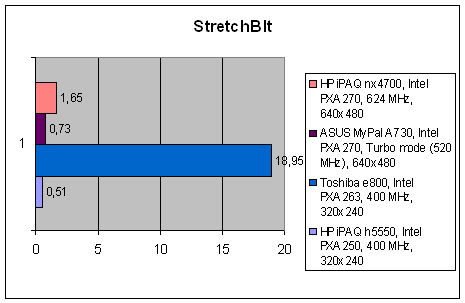
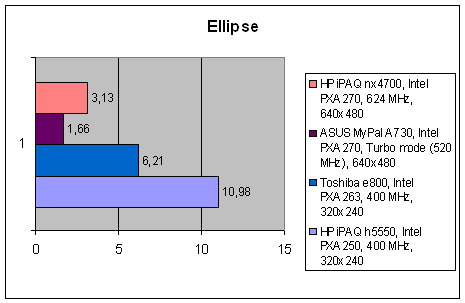
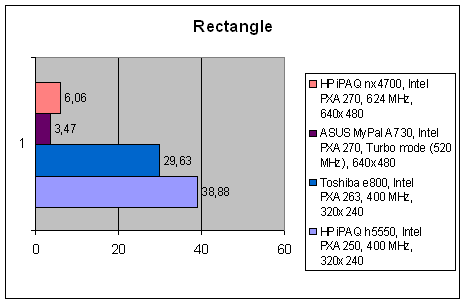
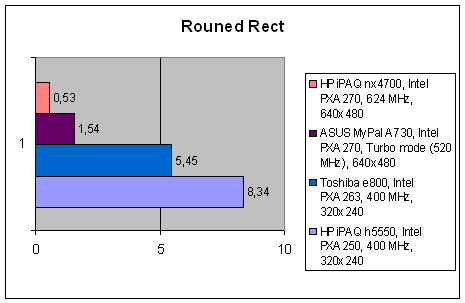
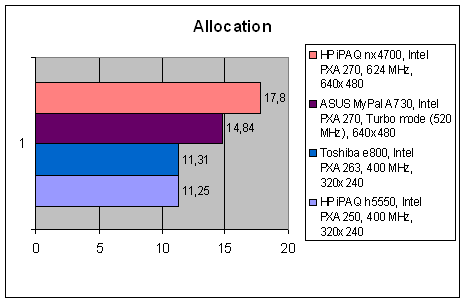
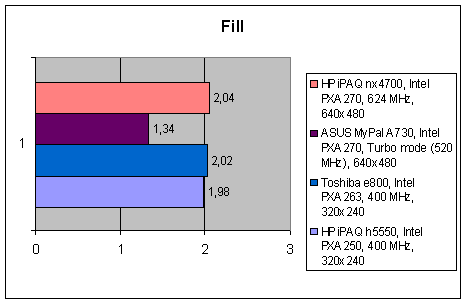
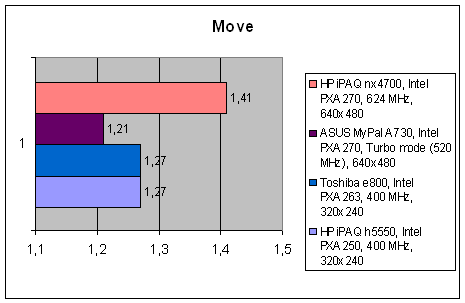
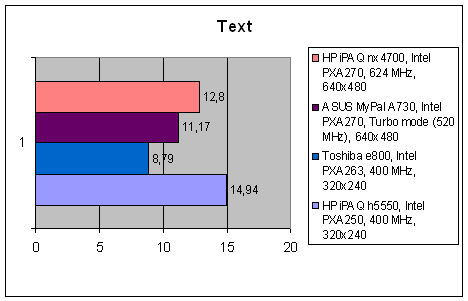
| 3 | 4 |
| Test | HP iPAQ h5550, Intel PXA250, 400 MHz, 320x240 | Toshiba e800, Intel PXA263, 400 MHz, 320x240 | ASUS MyPal A730, Intel PXA270, Turbo mode (520 MHz), 640x480 | HP iPAQ nx4700, Intel PXA270, 624 MHz, 640x480 |
| CPU FP |
|
|
|
|
| CPU Int |
|
|
|
|
| Graphics/Bitmap/BitBlt |
|
|
|
|
| Graphics/Bitmap/StretchBlt |
|
|
|
|
| Graphics/Filled/Ellipse |
|
|
|
|
| Graphics/Filled/Rectangle |
|
|
|
|
| Graphics/Filled/Rounded Rect |
|
|
|
|
| Memory/Allocation |
|
|
|
|
| Memory/Fill |
|
|
|
|
| Memory/Move |
|
|
|
|
| Text |
|
|
|
|











First I want to note that our comparison based on the test results of HP iPAQ hx4700 and some previous top models is not correct to some extent, because it includes PDAs operating in VGA and QVGA modes. However those huge differences demonstrated sometimes by test applications in different graphic modes partly reflect the situation with the real PDA performance with different displays. Indeed, in case of VGA, a graphics system with the unchanged architecture has to render the screen four times as large, which results in the correspondingly increased volume of processed and transferred data. Thus, the same hardware platform operating with QVGA and VGA displays theoretically must demonstrate the performance four times as low in graphics tests in the latter case. Let's see what happens in reality.
CPU tests expectedly demonstrate that the speed of integer calculations and floating point operations in all XScale processors directly depends on their frequency. Though the new PXA270 line demonstrates the integer index gain surpassing the frequency increase percentage. 624 MHz version is almost twice as fast as 400 MHz chips of the previous generation, though the frequency gain is only 50 %. In real number operations the relationship is in direct proportion to the frequency, it's all up to "pure" megahertz.
Now about graphics. First of all I want to note outstanding results of Toshiba e800 (but only in QVGA mode). We should attribute them to the fact that VOBenchmark "can" use features of the ATI Imageon graphics accelerator. This cannot be said about Spb Benchmark. It totally ignores the accelerator, which results in ugly low results demonstrated by e800. So let's limit ourselves to the direct comparison of VGA PDAs with the results of HP iPAQ h5550, which uses built-in graphics system from Intel. It turned out that Pocket PC performance in VGA mode is approximately more than four times as low as in QVGA mode. Inconsistencies in various tests testify not only to completely different design approaches to the video system but also to the inability of old test programs to adequately measure performance of new top models in VGA mode. Indeed, it would be wrong to say that the interface response of ASUS MyPal A730 is subjectively 10 times as slow as in HP iPAQ h5550. Yes, the slowdown is noticeable, but it's not that much as demonstrated by the tests.
If you compare the video performance of two VGA PDAs – ASUS MyPal A730 and HP iPAQ hx4700 – you may notice that the HP device is much faster. If not take into account a very strange drop in the test that draws a rectangle with rounded corners, you can notice that on average the HP model is more than twice as fast as the ASUS model. This allows us to say that the video system is much better in hx4700.
Memory performance tests demonstrate that HP engineers did an excellent job here. Seek speed depends on the CPU frequency – the data is not transferred along the memory bus here, and everything is up to the time it takes to form requests. By data transfer rates hx4700 is either on a par with top PDAs or outscores them.
The complex test demonstrates that the total hx4700 performance and its interface response times are approximately on a par with good PDAs operating in QVGA mode. As you can see, the CPU clock had to be increased to 624 MHz in order to compensate the increased volume of processed data in VGA mode. And still there remain some tasks where the VGA PDA operates slower than devices with the lower screen resolution. Device architecture offers some issues to pause and think about, because the speculative upgrade to 800x600 resolution (it's quite possible with the latest technologies just at a small increase of display size) will be very hard for the current architecture.
Battery life time test provided quite good results. With the backlight set to maximum, Spb Benchmark in the Maximum Backlight, Standard Usage mode (user applications run in cyclic sequence) showed 5 hours 11 minutes. It's quite a good result. So, in order to provide the battery life time usual for top PDAs, this 624 MHz VGA resolution model had to be equipped with a 1800 mAh battery.
| 3 | 4 |